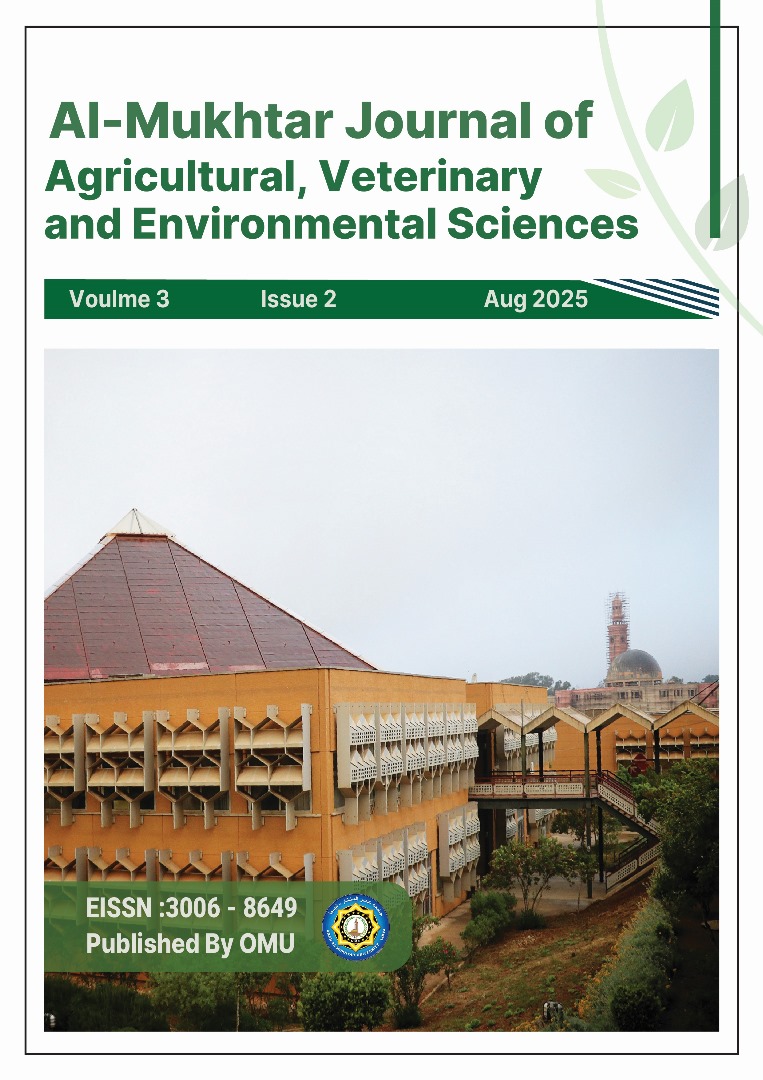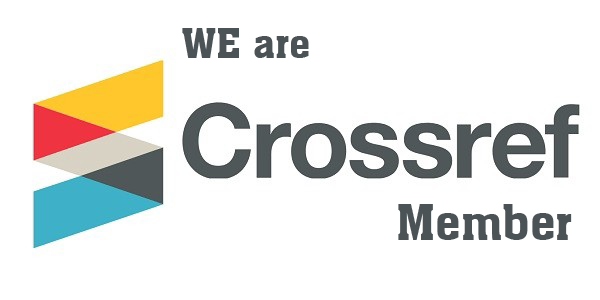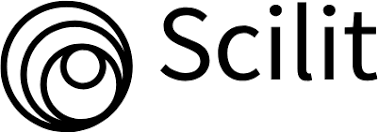Pollen viability in natural populations of Thymus capitatus the south Al-Jabal Al-Akhdar area, Cyrenaica, Libya.
DOI:
https://doi.org/10.54172/90ygmj19الكلمات المفتاحية:
Pollen viability; acetocarmine staining method; Thymus capitatus; El-Jabal El-Akhdar; Libya.الملخص
Viable pollen plays a crucial role in the process of seed formation and acts as the principal mechanism for gene transfer in outcrossing species such as thyme (Thymus capitatus). There is a lack of information on the pollen viability of natural populations of Libyan thyme that grow in the south El-Jabal El-Akhdar area. This research estimated pollen viability using acetocarmine staining method. It was possible to distinguish between viable pollen (non-aborted) and nonviable (aborted) pollen using acetocarmine stain. The viability of pollen percentage in T. capitatus accessions was found to be significantly different. The viable pollen recorded as highest was obtained from the white-flowered population (67.61%) followed by dotted white-flowered population (57.24%), while the lowest viable pollen was obtained from mosaic- lowered population (29.86%). The remaining two populations, violet-flowered and purple-flowered showed 55.73% and 42.38% respectively as pollen viability percentage. Variation was also observed in the pollen viability among different collection periods. These results suggested that pollen viability may be under both environmental and genetic control
المراجع
Adhikari K. and Campbell C. (1998). In vitro germination and viability of buckwheat (Fagopyrum esculentum Moench) pollen. Euphytica 102(1): 87–92.
Alexander MP (1969). Differential staining of aborted and non-aborted pollen. Stain Technology 44: 117-122.
Ali, E. S. (2008). Behavior of chromosomes during meiosis in wild olive. Journal of Agricultural Research, Kafrelsheikh University, 34(3): 808-819. (in Arabic, with English abstract).
Ali, E. S. and Bataw, M. (2014). Pollen grains viability in Thapsia garganica from Al-jabal Al-akhder region, Libya. Al-Mukhtar Journal of Sciences, 29(1):140-148. (in Arabic, with English abstract).
Ali, E. S. and Mustafa, H. M. (2019). Polymorphism in thyme (Thymus capitatus) at southern re-gion of El-Jabal El-Akhdar, Libya. Bayan Scientific journal, 4:47-62. (in Arabic, with Eng-lish abstract).
Ali, E. S. and Mustafa, H. M. (2021). Isoenzyme diversity for peroxidase among Libyan thyme (Thymus capitatus) populations. Bayan Scientific journal, 9:658-664.
Ali, E. S., Mustafa H. M. and K. A. Omaar (2022). Phylogenetic Analysis of Libyan Thyme (Thy-mus Capitatus) Inferred from The Morphological Traits. Al-Mukhtar Journal of Sciences 37 (4): 385-393,
Amkul, K., Panngam, M., Tanya, P., Srinives, P. and Laosatit, K. (2016). Pollen viability and seed set of interspecific hybrids between Jatropha curcas × Jatropha integerrima. Genomics and Genetics, 9(1): 50-55.
Beardsell, D. V., Knox, R. B. and Williams, E. G. (1993). Breeding system and reproductive suc-cess of Thryptomene calycina (Myrtaceae). Australian Journal of Botany, 41:333-353.
Becker, W. A. and Ewart, L. C. (1990). Pollination, seed set and pollen tube growth investigation in Viola redata L. Acta Horticulture, 272:33-36.
Beyhan N. and Serdar U. (2008). Assessment of pollen viability and germinability in some Euro-pean chestnut genotypes (Castanea sativa L.). Hort. Sci. 35(4): 171–178.
Bots M. and Mariani C. (2005). Pollen viability in the field. Radboud Universiteit Nijmegen. Re-port COGEM. p. 13–15.
Dafni A. and Firmage D. (2000). Pollen viability and longevity: Practical, ecological and evolu-tionary implications. Plant Syst. Evol. 222(1–4): 113–132.
Dafni, A., Kevan P., Gross L. and K. Goka (2010). Bombus terrestris, pollinator, invasive and pest:An assessment of problems associated with its widespread introductions for commer-cial purposes. Appl. Entomol. Zool. 45 (1): 101–113.
Divakara, B. N., Upadhyaya, H. D., Wani, S. P., Laxmipathi-Gowda, C. L. (2010). Biology and ge-netic improvement of Jatropha curcas L.: a review. Appl. Energy, 87: 732-742.
Firtz S.E. and Lukaszewski A.J. (1989). Pollen longevity in wheat, rye and triticale, Plant Breed-ing, 102:31-34.
Grant, V. (1981). Plant Speciation. 2nd edition. New York, Columbia Univ. Press.
Guoren He, Fengrong Hu, Jun Ming , Chun Liu and Suxia Yua (2017). Pollen viability and stig-ma receptivity in Lilium during anthesis Euphytica, (1): 213-231.
Heidmann, I., and Di-Berardino, M. (2017). Impedance flow cytometry as a tool to analyze micro-spore and pollen quality. Methods Mol. Biol., 1669: 339–354.
Heidmann, I., Schade-Kampmann, G., Lambalk, J., Ottiger, M., and Di Berardino, M. (2016). Im-pedance flow cytometry: a novel technique in pollen analysis. PLoS One 11:e0165531.
Heslop-Harrison, J., Heslop-Harrison, Y. and Shivanna, K. R. (1984). The evaluation of pollen quality, and a further appraisal of the fluorochromatic (FCR) test procedure. Theor. Appl. Genet., 67: 367-375.
Kelly, J. K., Rasch A. and Rasch, S. Rasch. (2002). A method to estimate pollen viability from pollen size variation. American Journal of Botany, 89: 1021–1023.
Kuniyal, C. P., Rajsekaran, C. Prasad, P. and Bhadula, S. K. (2003). Multiplication of Aconitum atrox (Bruhl) Muk., via tuber segments. Int. Plant Genet. Resour. Newsletter , 135:59-62.
Lankinen A., Sandra A. M., Lindstrom and Tina D'Hertefeldt (2018). Variable pollen viability and effects of pollen load size on components of seed set in cultivars and feral populations of oilseed rape. https://doi.org/10.1371/journal.pone.0204407.
Lincoln, R. J., Boxshall, G. A. and Clark, P. F. (1982). A dictionary of ecology, evolution and sys-tematics. Cambridge University Press.
Lingren, D., Paule, L., Xihuan, S., Yazdani, R., Segerstrom, U., Wallen, J. and Lijdebro, M. L. (1995). Can viable pollen carry Scots pine genes over long distances? Grana, 34:64-69.
Mantiquilla J. A., Elumba M., Adtoon1 J. A., Abad R. G., Cyrose S., Millado S., and Gilda C. R. (2018). In vitro germination and viability testing of Nipa(Nypa fructicans Wurmb.) pollen under different storage conditions. Philippine Journal of Science 147 (4): 617-627.
Maryam, M, Jafar, J., Bilques, F., Salman, H., Summar, A., Naaqvi, N., Rashid, A., and Iqrar, A. Khan (2015). Ealuation of pollen viability in date plam cultivars under different storage temperatures. Pak. J. Bot., 47(1): 377-381.
Marutani, M., Sheffer, R. D. and Kameto, H. (1993). Cytological analysis of Arithurium andrae-num (Araceae), its related taxa and their hybrids. American Journal of Botany, 80:93-103.
McKellar, M. A and Quesenberry, K. H. (1992). Chromosome pairing and pollen viability in Des-modium ovalifolium Wall x Desmodium heterocarpon (L.) DC hybrids. Australian Journal of Botany, 40:243-247.
Migdałek, G., Kolczyk, J., Pliszko, A., Kościńska-Pająk, M. and Słomka, A. (2014). Reduced pol-len viability and achene development in Solidago × niederederi Khek from Poland. Acta Soc. Bot. Pol., 83(3):251–255.
Morse, D. H. (1987). Roles of pollen and ovary age in follicle production of the common milk-weed Asclepias syriaca. American Journal of Botany, 72: 527-536.
Murugan, R., Shivanna, K. R. and Rao, R. R. (2006). Pollination biology of Aristolochia tagala, a rare species of medicinal importance. Curr. Sci., 91(6):795-798.
Niesenbaum, R. A. (1992). Sex ratio, components of reproduction and pollen deposition in Lin-derabenzoin (Lauraceae). American Journal of Botany, 79(5):495-500.
Nyman, Y. (1992). Pollination mechanisms in six Campanula species (Campanulaceae). Pl. Syst. Evol., 181:97-108.
Parfitt D.E. and Ganeshan S. (1989). Comparison of procedures for estimating viability of Prunus pollen. HortScience 24:354–356
Parashuram, M., Pavan Kumar, P., Raghavendra, G., Shirol, A., Bapuraygouda, P, Jameel M. and Shankar, M. (2021). Assessment of pollen viability and in vitro pollen germination in Ne-rium cultivars (Nerium oleander L.).International Journal of Chemical Studies, 9(2): 724-728.
Radovid, A., Nikolid, D., Milatovid, D., Rakonjac, V. and Bakid, I. (2017). Pollen viability in some Quince cultivars. 3rd International Symposium for Agriculture and Food (ISAF).
Rathod V., Behera T., Munshi A., Durgesh K., Krishnan B. and Sharma N. (2018). Pollen viability and in vitro pollen germination studies in Momordica species and their intra and inter-specific hybrids. International Journal of Chemical Studies, 6(6): 32-40.
Richards, A. J. (1997). Plant Breeding Systems. Chapman and Hall, London.
Robles-González, M., ,Cortez-Arroyo, A., Carrillo-Medrano, S. and Medina-Urrutia, V. (2019). Viability and longevity of pollen in Mexican lemon genotypes estimated by in vitro ger-mination. Revista Mexicana Ciencias Agrícolas,10 (4):911-920.
Rodriguez-Riano, T. and Dafni, A. (2000). A new procedure to assess pollen viability. Sex. Pl. Repr., 12:241-244.
Sharafi, Y. (2011). Investigation on pollen viability and longevity in Malus pumila L., Pyrus commonis L., and Cydonia oblonga L., in vitro. Journal of Medicinal Plants Research, 5(11): 2232-2236.
Shivanna, K. R. (2003). Pollen Biology and Biotechnology. Science Publishers, Inc., USA, pp. 181–182.
Shivanna, K. R. and Tandon, R. (2014). Reproductive Ecology of Flowering Plants: A Manual; Springer. New Delhi, India.
Shivashankara, K. S., Geetha, G. A. and Roy, T. K. (2019). Metabolite profiling in Mango (Man-gifera indica L.) pollen grains in relation to viability. J. Hortl. Sci., 14(1) : 33-42.
Słomka A, Bohdanowicz J, Poznańska E, Kwiatkowska M, Pilarska M and Struebig M (2014). Usefulness and limitations of pollen characters in environmental studies based on Viola L. species (sect. Melanium Ging.). Mod Phytomorphology, 5:31–34.
Smith-Huerta, N. L. and Vasek, F. C. (1984). Pollen longevity and stigma pre-emption in Clarkia. American Journal of Botany, 71(9):1183-1191.
Stanley, R. and Linskens, H. (1974). Pollen. Biology, biochemistry, management. -Springer. Ber-lin, Heidelberg.
Stone, J. L., Thomson, J. D. and Dent, A. S. J. (1995). Assessment of pollen viability in hand-pollination experiments: A review. American Journal of Botany, 82:1186–1197.
Thomson, JD (1989). Germination schedules of pollen grains: implications for pollen selection. Evolution; 43: 220-223. https://doi.org/10.1111/j. PMID: 28568494
Thomson, JD., Rigney, L. P, Karoly, K. M. and Thomson, B. A. (1994). Pollen viability, vigor, and competitive ability in Erythronium grandiflorum (Liliaceae). American Journal of Botany, 81:1257–1266.
Tiwari A., Kamble RB., and Chaturvedi A. (2014). Pollen biology of some members of Euphorbi-aceae family. Asian J Plant Sci Res, 4: 8–14.
Vijayakumar, R., TK B., Munshi, A. Kumar, D., G. Jat, Boopala Krishnan, G. and N. Sharma (2018). Pollen viability and in vitro pollen germination studies in Momordica species and their intra and interspecific hybrids. International Journal of Chemical Studies,6(6): 32-40.














